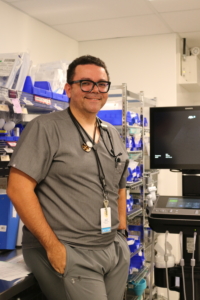St. Boniface Hospital’s Emergency Department serves as the front door of the Hospital and, in many respects, the health-care system, says Dr. Harold Peters.
Peters has worked as a physician in the Emergency Department at St. B since 2017. “The first impressions of most patients and their family members are set in their experiences in our Emergency Department,” he said.
“That shapes their experience of illness throughout their entire stay.”
The populations the Emergency Department serves in Manitoba and Northwestern Ontario are growing. People are generally living longer, notes Peters. “So, disease is getting more complicated. The needs of the health-care system have been increasing significantly,” he said.
Time and other factors have put pressure on the department, however. The Hospital’s current Emergency Department was built in 1955 and has operated with minimal updates for almost 70 years.
“I can tell you our current infrastructure is overloaded. The building itself is relatively old, and that makes it difficult for us to manage increasingly complex issues with patients,” Peters continued. Moving patients from the Emergency Department throughout the Hospital for diagnostics or treatment has become more difficult, owing to the aging facility, he added.
The redevelopment project currently underway at the Hospital will result in a modern space where Peters says he and his colleagues will be able to better offer compassionate, high-quality, advanced resuscitation and critical care to patients.

Moving patients problematic
Space limitations in the Emergency Department make moving patients difficult, when necessary.
Peters gives as an example a critically sick patient, on a ventilator with multiple pumps and monitors, whose diagnosis and subsequent treatment requires a CT scan.
“We have to get the patient onto an elevator, and move them around through a series of hallways, just to reach the CT scanner,” he explained. “This sort of long and complex move, for a ventilated patient, can take 20 to 30 minutes from the time they leave the Department to the time they return.”
At least one nurse, up to two health-care aides, and even sometimes the physician themselves have to stay with the patient during that time, Peters noted. It can be much harder to manage if the patient has a Code Blue, cardiac arrest, outside of the Department, he said.
When St. B’s new Emergency Department opens in 2025, it will have a CT scanner and diagnostic imaging machines that are connected to the main resuscitation area. To Peters, that means the same patient can be scanned “literally by going through a doorway and then coming right back,” he said.
“Assuming all goes well, that can take five to ten minutes. That will make all the difference with someone who is critically sick. Your movements are significantly improved; that’s a huge help in providing acute care. And you are taking staff out of the Department for a significantly shorter time period,” he said.
Larger space, more natural light
Emergency Department wait times and bottlenecks are a well-known issue in hospitals across Winnipeg – St. B included. In his job, Peters sees patients who are spending a lot of time waiting for admission to the Hospital. They get stuck in windowless rooms with very little privacy or space, he acknowledged. The new Department will help solve some of these problems.
“Having more space will allow us to have patients stretch their legs a bit more,” said Dr. Peters. “Also, having more natural light will be a huge benefit to patients who have to spend longer times in the Department. My hope is that the experience of both patients and staff will be improved.”
The new Department will offer several quick break rooms where staff can take the time they need. Peters says these rooms will provide staff with quiet, private spaces to get away and collect themselves. This can be a welcome relief for our professional caregivers during long shifts or the emotional and difficult circumstances that can happen in Emergency Departments.
“It will be more modern,” said Peters. “For instance, it will have a dedicated breastfeeding area for staff. We have lots of younger nurses, clerks, and health-care aides who work here who have small children and babies. They often need to pump breast milk when they are on shift. Even some of our emergency physicians are often young mothers, and they need to pump.”


